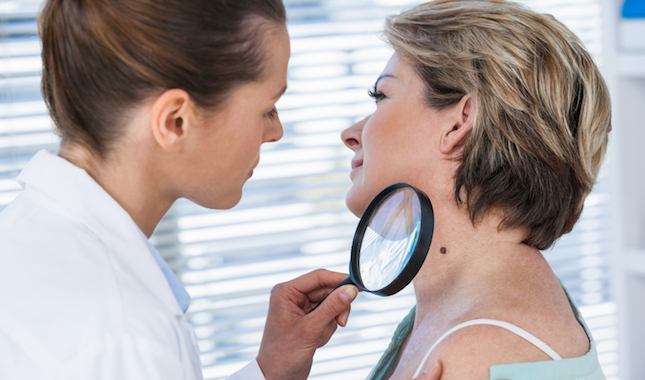Skin Cancer Prevention-What You Need to Know
With millions of people affected each year, non-melanoma skin cancer is the most common type of cancer in the United States. In fact, it’s estimated that nearly 9,500 people receive a skin cancer diagnosis every day.
The good news? You can help prevent skin cancer by minimizing exposure to the sun’s harmful UV rays. Familiarizing yourself with the skin cancer early signs also plays an important role in prevention. Here’s what you need to know about skin cancer and sun safety. If you have any of the following symptoms, visit your local MD Now Urgent Care center for treatment. Or, if need be, we can refer you to a dermatologist in your area.
What are the Different Types of Skin Cancer?
Knowing the skin cancer early signs is important when it comes to diagnosis and prevention. Here are the four different types of skin cancer and their warning signs:
Actinic Keratosis
Actinic keratosis involves scaly patches or spots that form after years of sun exposure. These precancerous growths usually form after a person reaches 40 years old, since they take years to develop. They’re usually found on the head, neck, forearms, or hands. Actinic keratosis often progresses to squamous cell carcinoma, making early treatment important.
Basal Cell Carcinoma
People with fair skin are more likely to develop basal cell carcinoma, which is the most prevalent type of skin cancer. However, darker-skinned people can still develop this condition. Basal cell carcinoma often looks like a flesh-colored bump that resembles a pearl.
Squamous Cell Carcinoma
The second most-common type of skin cancer, squamous cell carcinoma, presents itself as a firm red bump, scaly patch, or a sore that re-opens after it heals. Like other types of skin cancer, SCC forms on areas that receive frequent sun exposure. Early diagnosis of SCC can prevent it from spreading to other parts of the body.
Melanoma
The deadliest type of skin cancer, melanoma, frequently develops inside an existing mole, though it can also appear as a new dark spot. Receiving melanoma treatment during its early stages is critical to a successful recovery. Monitoring moles regularly for irregularities and changes in shape can help prevent melanoma.
How Can I Check for Skin Cancer?
Examining the skin regularly for skin cancer symptoms is the best way to ensure early treatment of skin cancer. When it comes to early skin cancer prevention, remember the ABCDEs:
- Asymmetry: Moles should be symmetrical in appearance.
- Border: Jagged or irregular borders are warning signs of skin cancer.
- Color: A mole that changes color or features multiple colors can be cause for concern.
- Diameter: Melanomas typically are larger than a pencil eraser, or 6 millimeters.
- Evolving: Any growth or mole that changes regularly should be examined.
What Skin Cancer Treatment Options Are Available?
Skin cancer treatment is determined by the stage of the cancer, its location, and other factors, like your current health and age. Surgery to remove the growth, immunotherapy, targeted therapy, radiation therapy, and chemotherapy are all treatment options for malignant growths.
Surgery can be a successful melanoma treatment when the cancer is caught during its early stages. However, more advanced cancers may require multiple approaches to skin cancer treatment.
Who Is at Risk of Skin Cancer?
The risk of skin cancer generally increases as you age, which is due to accumulated exposure to UV rays. However, skin cancer symptoms can strike at any age, especially affecting those who spend a lot of time outdoors. Those who experienced frequent sunburns as children are more likely to develop skin cancer earlier in life.
Caucasians have a greater risk of developing skin cancer than non-white individuals. Those who freckle or sunburn easy also have an increased risk. Genetics also play a role in skin cancer risk—if your parents or siblings have suffered from skin cancer, the chances of a growth increases.
How Can I Prevent Skin Cancer?
Taking a few precautions before heading out in the sun can save your life. Here are a few easy skin cancer prevention tips:
- Spend time in the shade, especially between 10 a.m. and 4 p.m.
- Avoid outdoor tanning and UV tanning beds, and especially avoid sunburn.
- Wear a broad-brimmed hat and UV-blocking sunglasses when outside.
- Use sunscreen of SPF 15 or higher every day. If you’ll be spending several hours outdoors, use a water-resistant formula with SPF 30 or above.
- See a physician each year for a thorough skin exam.
Early skin cancer prevention and detection can help you lead a cancer-free life. If you notice a suspicious spot or other skin cancer symptoms, visit your nearest MD Now Urgent Care center or dermatologist immediately.
To learn more about our urgent care centers, call 888-MDNow-911 or visit www.MDNow.com.
MD Now® Urgent Care Walk-In Medical Centers is the leading provider of fast and affordable urgent care to adults and children in Palm Beach, Broward, and Miami-Dade counties. Our state-of-the-art, walk-in medical centers are open seven days a week to deliver an affordable and convenient alternative to long emergency room wait times and the limited hours of family physicians. No appointment is necessary and major insurance plans are accepted. In addition to providing a comprehensive range of urgent care services to treat a variety of illnesses and injuries, our multiple locations offer digital x-rays, EKG, lab testing, physicals, immunizations, vaccines, occupational medicine, travel medicine and selected primary care services. Find the medical care you need with the convenience you want at MD Now. Call: 888-MDNow-911, online: www.MDNow.com.

